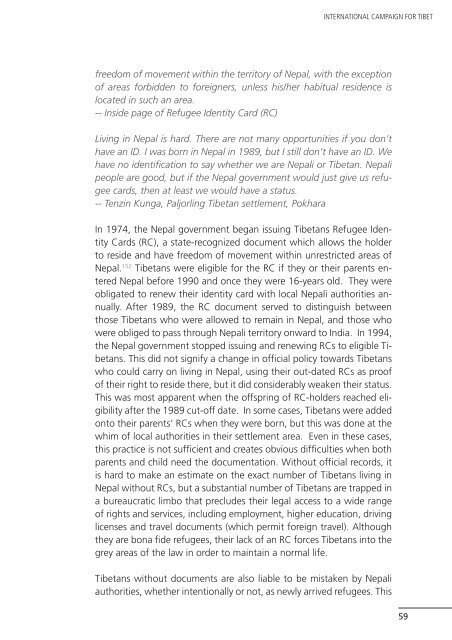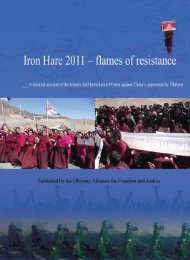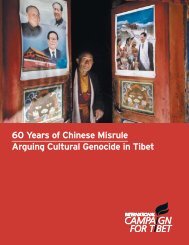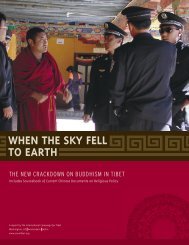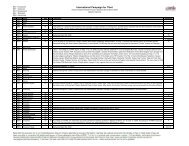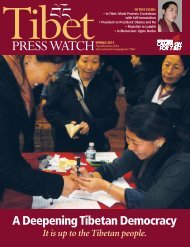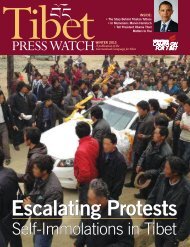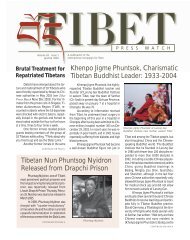DANGEROUS CROSSING: - International Campaign for Tibet
DANGEROUS CROSSING: - International Campaign for Tibet
DANGEROUS CROSSING: - International Campaign for Tibet
You also want an ePaper? Increase the reach of your titles
YUMPU automatically turns print PDFs into web optimized ePapers that Google loves.
INTERNATIONAL CAMPAIGN FOR TIBET<br />
freedom of movement within the territory of Nepal, with the exception<br />
of areas <strong>for</strong>bidden to <strong>for</strong>eigners, unless his/her habitual residence is<br />
located in such an area.<br />
-- Inside page of Refugee Identity Card (RC)<br />
Living in Nepal is hard. There are not many opportunities if you don’t<br />
have an ID. I was born in Nepal in 1989, but I still don’t have an ID. We<br />
have no identification to say whether we are Nepali or <strong>Tibet</strong>an. Nepali<br />
people are good, but if the Nepal government would just give us refugee<br />
cards, then at least we would have a status.<br />
-- Tenzin Kunga, Paljorling <strong>Tibet</strong>an settlement, Pokhara<br />
In 1974, the Nepal government began issuing <strong>Tibet</strong>ans Refugee Identity<br />
Cards (RC), a state-recognized document which allows the holder<br />
to reside and have freedom of movement within unrestricted areas of<br />
Nepal. 152 <strong>Tibet</strong>ans were eligible <strong>for</strong> the RC if they or their parents entered<br />
Nepal be<strong>for</strong>e 1990 and once they were 16-years old. They were<br />
obligated to renew their identity card with local Nepali authorities annually.<br />
After 1989, the RC document served to distinguish between<br />
those <strong>Tibet</strong>ans who were allowed to remain in Nepal, and those who<br />
were obliged to pass through Nepali territory onward to India. In 1994,<br />
the Nepal government stopped issuing and renewing RCs to eligible <strong>Tibet</strong>ans.<br />
This did not signify a change in official policy towards <strong>Tibet</strong>ans<br />
who could carry on living in Nepal, using their out-dated RCs as proof<br />
of their right to reside there, but it did considerably weaken their status.<br />
This was most apparent when the offspring of RC-holders reached eligibility<br />
after the 1989 cut-off date. In some cases, <strong>Tibet</strong>ans were added<br />
onto their parents’ RCs when they were born, but this was done at the<br />
whim of local authorities in their settlement area. Even in these cases,<br />
this practice is not sufficient and creates obvious difficulties when both<br />
parents and child need the documentation. Without official records, it<br />
is hard to make an estimate on the exact number of <strong>Tibet</strong>ans living in<br />
Nepal without RCs, but a substantial number of <strong>Tibet</strong>ans are trapped in<br />
a bureaucratic limbo that precludes their legal access to a wide range<br />
of rights and services, including employment, higher education, driving<br />
licenses and travel documents (which permit <strong>for</strong>eign travel). Although<br />
they are bona fide refugees, their lack of an RC <strong>for</strong>ces <strong>Tibet</strong>ans into the<br />
grey areas of the law in order to maintain a normal life.<br />
<strong>Tibet</strong>ans without documents are also liable to be mistaken by Nepali<br />
authorities, whether intentionally or not, as newly arrived refugees. This<br />
59


